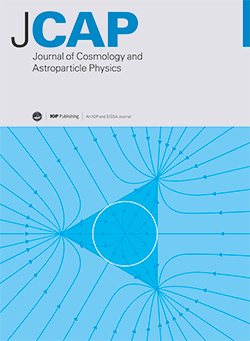Decay rate of PQ-ball
IF 5.3
2区 物理与天体物理
Q1 ASTRONOMY & ASTROPHYSICS
Journal of Cosmology and Astroparticle Physics
Pub Date : 2025-07-17
DOI:10.1088/1475-7516/2025/07/057
引用次数: 0
Abstract
Q-balls are non-topological solitons that arise in theories with a complex scalar field possessing a conserved global U(1) charge. Their stability is ensured by this charge, making them potentially significant in cosmology. In this paper, we investigate Q-ball-like objects in scenarios where the scalar field acquires a finite vacuum expectation value, spontaneously breaking the global U(1) symmetry. A well-motivated example is the Peccei-Quinn field, where the U(1) symmetry is identified as the Peccei-Quinn symmetry, and hence we refer to such objects as PQ-balls. We first discuss the existence of stable PQ-ball solutions in a finite-density plasma and argue that they become unstable in vacuum. Using detailed numerical simulations under spherical symmetry, we confirm their formation, compute their decay rate, and derive an analytical formula for it. Our results have important implications for axion cosmology, particularly in the context of the kinetic misalignment mechanism.pq球的衰减率
q球是非拓扑孤子,出现在具有守恒全局U(1)电荷的复标量场的理论中。这种电荷保证了它们的稳定性,使它们在宇宙学中具有潜在的重要意义。本文研究了类q球物体在标量场获得有限真空期望值的情况下,自发地打破了全局U(1)对称性。一个很好的例子是Peccei-Quinn场,其中U(1)对称被识别为Peccei-Quinn对称,因此我们将这样的物体称为pq球。我们首先讨论了有限密度等离子体中稳定pq -球解的存在性,并论证了它们在真空中变得不稳定。在球对称条件下进行了详细的数值模拟,证实了它们的形成,计算了它们的衰减率,并推导了它们的解析公式。我们的结果对轴子宇宙学具有重要意义,特别是在动力学失调机制的背景下。
本文章由计算机程序翻译,如有差异,请以英文原文为准。
求助全文
约1分钟内获得全文
求助全文
来源期刊

Journal of Cosmology and Astroparticle Physics
地学天文-天文与天体物理
CiteScore
10.20
自引率
23.40%
发文量
632
审稿时长
1 months
期刊介绍:
Journal of Cosmology and Astroparticle Physics (JCAP) encompasses theoretical, observational and experimental areas as well as computation and simulation. The journal covers the latest developments in the theory of all fundamental interactions and their cosmological implications (e.g. M-theory and cosmology, brane cosmology). JCAP''s coverage also includes topics such as formation, dynamics and clustering of galaxies, pre-galactic star formation, x-ray astronomy, radio astronomy, gravitational lensing, active galactic nuclei, intergalactic and interstellar matter.
 求助内容:
求助内容: 应助结果提醒方式:
应助结果提醒方式:


